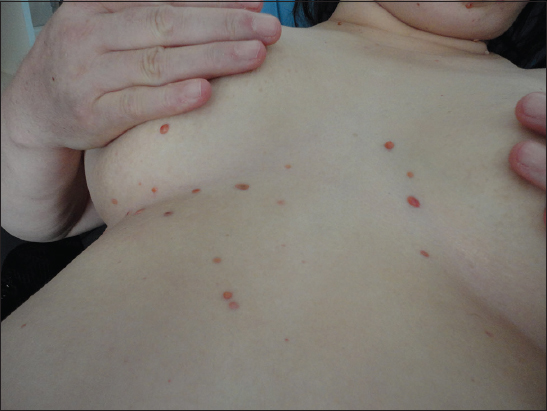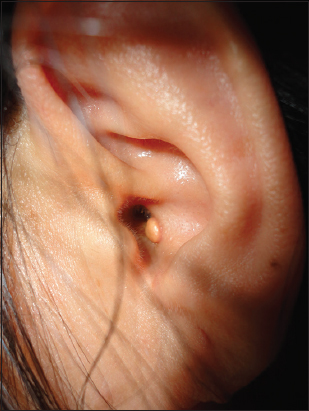A case of adult onset disseminated juvenile xanthogranuloma
Havva Hilal Ayvaz1, Gökçen Çelik1, Müzeyyen Gönül1, Arzu Kiliç2, Nimet Özcan2, Aysel Çolak3
1Dermatology Department, Ankara Diºkapi Yildirim Beyazit Education and Research Hospital, Ankara, Turkey, 2Dermatology Department, Ankara Numune Education and Research Hospital, Ankara, Turkey, 3Pathology Department, Ankara Numune Education and Research Hospital, Ankara, Turkey
ABSTRACT
Juvenile xanthogranuloma (JX) is a rare, benign, non-Langerhans histiocytic proliferative disease that etiology is unknown. It is usually seen in children and infants. JX in adult is very rare. A 41-year-old female patient was admitted to our clinic with papules on her face, torso and extremities. A few lesions had occured 3 years ago on her face, they disseminated all over her body after having a traffic accident one year ago which for she had operations and she also concurrently was diagnosed asdiabetes mellitus (DM). Based on clinical and histopathological findings, the diagnosis of JX was made. There is no systemic involvement of JX detected. JX seen in adults are very rare and usually associated with hematological malignancy. The present case is a rare adult onset disseminated JX case without malignancy association and representative for the opinion that trauma and DM may be triggering factors.
Key words: Non-Langerhans histiocytosis; Juvenile xanthogranuloma; Adult
INTRODUCTION
Juvenile xanthogranuloma (JX) is a rare, non-Langerhans histiocytic proliferative disease, generally seen in childhood [1]. JX in adult is very rare and in some of adult cases, there were reported concurrent hematological malignancies [2–4]. In the present case, a 41-year-old female patient who has disseminated JX lesions with adult onset is presented.
CASE REPORT
41 year old female patient was admitted to our clinic with papules all over her body. Lesions started 3 years ago on her face and they remained stabile until having a traffic accident 1 year ago. After accident and subsequently operation, the lesions began spreading on whole body. In her personal history, there were a surgical operation because of the accident and concurrently diagnosis of diabetes mellitus. In her family history there was nothing important. In dermatological examination, multiple yellowish-pink coloured, some dome-shaped, indurated papules were detected on her head, hairy skin, external auditory canal, pubis and upper torso (Figs 1 – 3). Routine laboratory tests were normal. Histopathological examination of the lesions showed histiocytic infiltration and multinuclear giant cells and actin, desmin, S100 and factor XIIIa stains were found negative whereas CD68 was positive (Figs a href=”#F4″>4a – d). Based on clinical and histopathological findings, patient was diagnosed as JX. There were no pathological findings in ocular and respiratory examinations of the patient. The patient was followed because the lesions has possibility of spontaneous resolution. But, 6 months later, there were no regression in control examination.
Prior to the study, patient gave written consent to the examination and biopsy after having been informed about the procedure.
DISCUSSION
JX is an uncommon non-langerhans histiocytic proliferative disease which %75 of cases were diagnosed in the first year of life. It is rarely seen in adults and the lesions generally seen as solitary and resisted to spontaneous regression [1]. Some of the adult cases with disseminated lesions were associated hematologic malignancy, mostly leukemias [2–4]. Our case is adult onset disseminated JX case without malignancy association.
The etiology of JX is still unknown however, it is suggested that it might be a reactive disorder responding to any traumatic or infectious stimulus [1]. Our case has trauma history and diabetes mellitus and dissemination of the lesions was simultaneously with trauma diagnosis of diabetes mellitus. So, we think that trauma and/or diabetes mellitus may be potential triggering factors for JX.
In many cases, lesions are limited to the skin and benign characterized [1]. Extracutaneous infiltration was reported in %5 of cases. The most common site are eye and lung. Early recognition is important to avoid complications [5]. In our case, there was no pathological findings in physical or radiological examinations that indicates any systemic involvement.
Associations between JX and neurofibromatosis type 1 (NF1), juvenile myelomonocytic leukemia (JML), urticaria pigmentosa, Niemann-Pick disease and diabetes mellitus were reported [6]. Our case has also diabetes mellitus.
Differential diagnosis firstly includes non Langerhans-Langerhans cell histiocytosis. The other differential diagnoses are xanthomas, molluscum contagiosum, neurofibroma, spitz nevus. Diagnosis of JX is done by clinical, histopathological and immunohistochemical examinations [7,8]. In histological examination of JX lesions, characterized Touton cells with ring shaped nucleus, foamy cytoplasma are seen and S100, CD1a stains are negative whereas CD68 stain is positive similarly in our case [9].
The lesions usually regress spontaneously in 3-6 years or sometimes with hyperpigmentation, atrophy or anetoderma. For diagnosis or cosmetic concerns, they could be excised [1]. Our case has multiple lesions, so excision was not suggested.
In conclusion, JX may occur in adult and dermatologist should keep in mind in the patients with yellowish-pink coloured, indurated papules. Trauma and diabetes mellitus may be a triggering factor for dissemination of JX.
CONSENT
The examination of the patient was conducted according to the Declaration of Helsinki principles.
REFERENCES
1. Goodman WT, Barret TL, Bolognia JL, Jorizzo J, Rapini R, HistiocytosesDermatology 2003; Vol.1: 1st ed. Edinburgh: Mosby; 1429-45.
2. Navajas B, Eguino P, Trébol I, Lasa O, Gardeazábal J, Díaz-Pérez JL, Multiple adult xanthogranulomaActas Dermosifiliogr 2005; 96: 171-4.
3. Biswas A, Hamid B, Coupland SE, Franks A, Leonard N, Multiple periocular adult onset xanthogranulomas in a patient with chronic lymphocytic leukemiaEur J Dermatol 2010; 20: 211-3.
4. Narvaez-Moreno B, Pulpillo-Ruiz A, De Zulueta-Dorado T, Conejo-Mir J, Disseminated juvenile xanthogranuloma associated with follicular lymphoma in an adult: successful treatment with chemotherapy and rituximabActas Dermosifiliogr 2013; 104: 242-6.
5. Chang MW, Update on juvenile xanthogranuloma: unusual cutaneous and systemic variantsSemin Cutan Med Surg 1999; 18: 195-205.
6. Cohen BA, Hood A, Xanthogranuloma: report on clinical and histological findings in 64 patientsPediatr Dermatol 1989; 6: 262-6.
7. Tahan SR, Pastel-Levy C, Bahn AK, Mihm MC, JrJuvenil xanthogranuloma: clinical and pathologic characterizationArch Pathol Lab Med 1989; 113: 1057-61.
8. Yamanaka K, Suita S, Kakumori S, Zaizen Y, Noguchi S, Tsuneyosi M, Juvenile xanthogranuloma of the pelvic origin: a case reportEur J Pediatr Surg 1995; 5: 246-7.
9. Fartasch M, Vigneswaran N, Diepgen TL, Hornstein OP, Immunohistochemical and ultrastructural study of histiocytosis X and non- X histiocytosesJ Am Acad Dermatol 1990; 23: 885-92.
Notes
Source of Support: Nil,
Conflict of Interest: None declared.




Comments are closed.